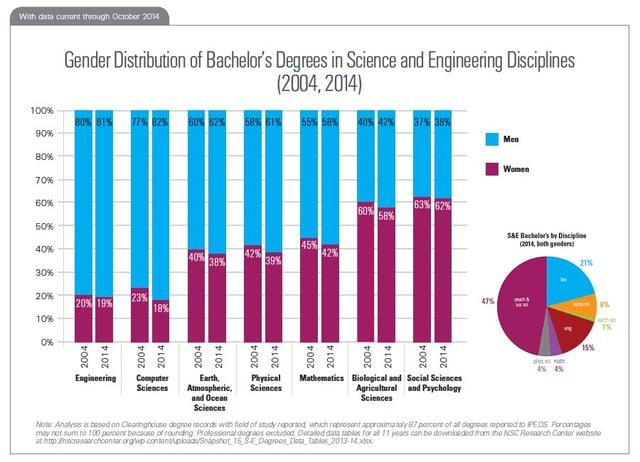You are invited to a child’s birthday party. As an adult with no children you have no idea what kids are into these days, and hope that your random purchase at Toys R’Us will be acceptable. When you enter their website or their store the first choice you make is based on the sex of the child. Is the child a boy or a girl? Although most of the toy categories under boy’s toys and girl’s toys are the same except for a few, within the categories you will see a difference. Within the building sets and blocks category the page looks different if you are in the boys or girls section. For example, girls have a Lego play house, and frozen treat stand. The boys have a technic hydroplane racer and Homing spider droid.


By the age of 15, girls interest in math and science drops. "Conformity to social expectations, gender stereotypes, gender roles and lack of role models continue to channel girls' career choices away from STEM fields” (Petroff, 2017). By the time college comes into play, women are enrolling at a higher number than men are (Borelleca, 2012). When you look at the breakdown of male and females enrolled in STEM majors, we see that not all science and engineering fields are male dominated.

For social sciences, psychology, biological and agricultural sciences there are actually more women enrolling than men. But engineering and computer science are still male dominated and even worse is that you see a drop in the percent of women studying science or engineering between 2004 and 2014. (Science & Engineering, 2016). Of the women who earn an engineering degree (20% of engineering graduates are women), 40% either quit or do not work in the engineering field after earning their degree (Silbey, 216).
When researchers asked why women they do not enter the engineering fields or enter and then leave the engineering field, many site the masculine culture to be the cause. Many experienced gendered treatment; such as being assigned the secretarial tasks or routine managerial work. They felt that their abilities to problem-solve and engage in challenging tasks was overshadowed by the fact that they were women. Some also cited experienced sexual harassment as a reason.
If we want women to be a part of the innovation that builds our future in the STEM fields, we need to make a change. Often times people want the solution to the problem to be a one step process. Point out the problem, fix the problem. Yet many problems are more complex than that. We need to address the way society pushes women out of STEM from birth to career. Making social change is difficult, and to those who are not a part of the disenfranchised group – it was often be invisible. Thus the first step is to notice the subtle ways in which our society communicates to women that STEM is not for them.
1. Give young girls STEM toys. Building blocks, robots, chemistry sets.
2. Stop commenting on girls looks. This communicates that their value lies in their looks. Comment on their abilities, their hard work, and bright futures.
3. Talk to girls about amazing women in the STEM field. Read about Jane Goodall, Youyou Tu and Katherine Johnson, and Eqbal Dauqan There are also a plethora of books for young children that encourage girls to engage in the STEM fields: 25 Books Starring Science-Loving Mighty Girls.
4. Within the workplace make sure you are evaluating people based on their abilities, not their sex. Don’t give the women you work with the less challenging work. They are there because they are qualified.
5. Although social change must start within yourself. Positive peer pressure is considered one of the most powerful ways to create change. When you see an injustice at your workplace be an upstander not a bystander. Because if you are not part of the solution you are part of the problem.
Take a look at this amazing video of the girls from Hamlin School having fun with NAO Robot and doing the #MannequinChallenge http://bit.ly/2uSw3Xk. Subscribe to our blog and stay tuned!
References
Petroff, A. (2017, February 28). The exact age when girls lose interest in science and math. Retrieved June 28, 2017, from http://money.cnn.com/2017/02/28/technology/girls-math-science-engineering/index.html
Borelleca, D. (2012, February 16). The Male-Female Ratio in College. Retrieved June 28, 2017, from https://www.forbes.com/sites/ccap/2012/02/16/the-male-female-ratio-in-college/#56b7ff02fa52
Science & Engineering Degree Attainment: 2004-2014. (2016, January 05). Retrieved June 28, 2017, from https://nscresearchcenter.org/snapshotreport-degreeattainment15/
Silbey, S. (2016, August 23). Why Do So Many Women Who Study Engineering Leave the Field? Retrieved June 28, 2017, from https://hbr.org/2016/08/why-do-so-many-women-who-study-engineering-leave-the-field

